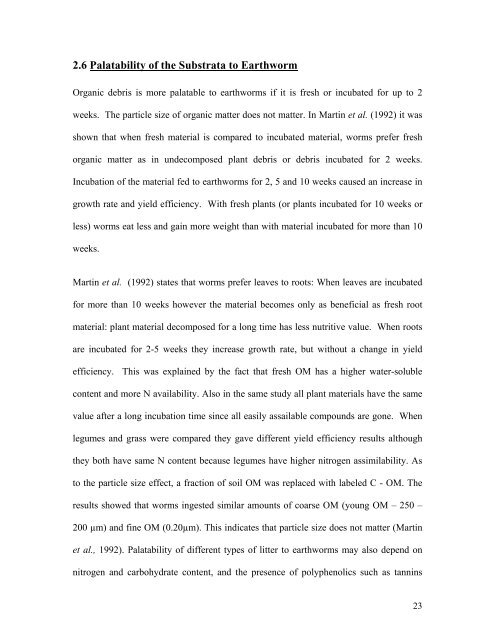Mekelle University The School of Graduate Studies Faculty of ...
Mekelle University The School of Graduate Studies Faculty of ...
Mekelle University The School of Graduate Studies Faculty of ...
- No tags were found...
You also want an ePaper? Increase the reach of your titles
YUMPU automatically turns print PDFs into web optimized ePapers that Google loves.
2.6 Palatability <strong>of</strong> the Substrata to EarthwormOrganic debris is more palatable to earthworms if it is fresh or incubated for up to 2weeks. <strong>The</strong> particle size <strong>of</strong> organic matter does not matter. In Martin et al. (1992) it wasshown that when fresh material is compared to incubated material, worms prefer freshorganic matter as in undecomposed plant debris or debris incubated for 2 weeks.Incubation <strong>of</strong> the material fed to earthworms for 2, 5 and 10 weeks caused an increase ingrowth rate and yield efficiency. With fresh plants (or plants incubated for 10 weeks orless) worms eat less and gain more weight than with material incubated for more than 10weeks.Martin et al. (1992) states that worms prefer leaves to roots: When leaves are incubatedfor more than 10 weeks however the material becomes only as beneficial as fresh rootmaterial: plant material decomposed for a long time has less nutritive value. When rootsare incubated for 2-5 weeks they increase growth rate, but without a change in yieldefficiency. This was explained by the fact that fresh OM has a higher water-solublecontent and more N availability. Also in the same study all plant materials have the samevalue after a long incubation time since all easily assailable compounds are gone. Whenlegumes and grass were compared they gave different yield efficiency results althoughthey both have same N content because legumes have higher nitrogen assimilability. Asto the particle size effect, a fraction <strong>of</strong> soil OM was replaced with labeled C - OM. <strong>The</strong>results showed that worms ingested similar amounts <strong>of</strong> coarse OM (young OM – 250 –200 µm) and fine OM (0.20µm). This indicates that particle size does not matter (Martinet al., 1992). Palatability <strong>of</strong> different types <strong>of</strong> litter to earthworms may also depend onnitrogen and carbohydrate content, and the presence <strong>of</strong> polyphenolics such as tannins23
















